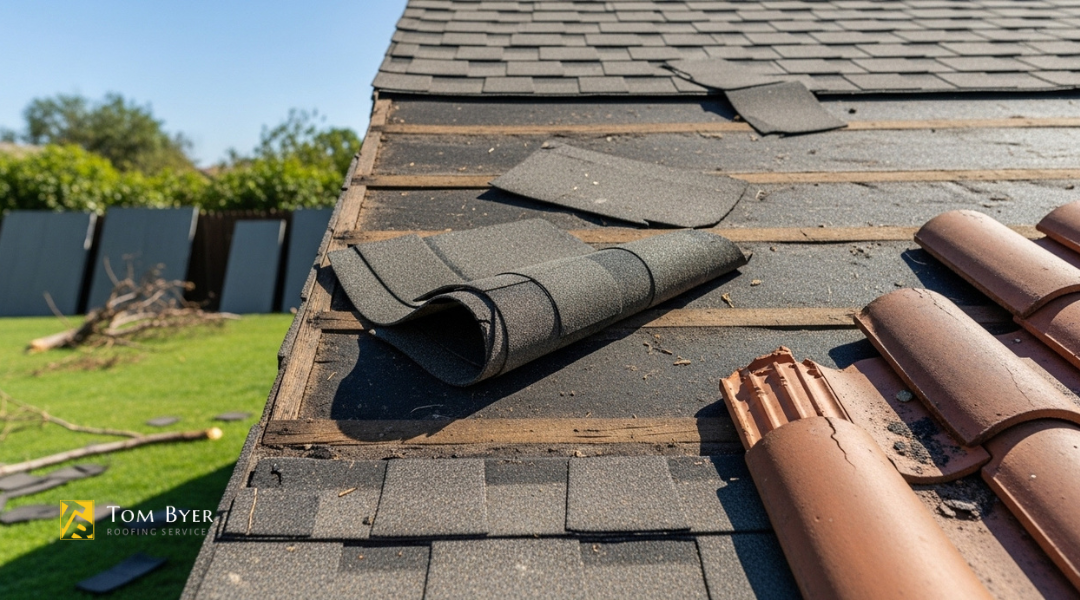Santa Ana winds and seasonal storms pose significant threats to Garden Grove roofs, with their powerful gusts and sudden weather changes capable of causing extensive damage in a matter of hours. These weather events can strip away shingles, compromise flashing, and expose your home to water damage that leads to costly repairs.
Preparing your roof before these seasonal storms arrive can prevent thousands of dollars in damage and protect your family’s safety. The key lies in understanding how these specific weather patterns affect roofing materials and taking proactive steps to strengthen vulnerable areas. Your roof faces unique challenges from the dry, heated winds that can reach speeds exceeding 70 mph, followed by sudden temperature drops and potential rainfall.
This comprehensive guide will walk you through identifying warning signs of roof vulnerability, implementing essential strengthening measures, and maintaining your roofing system throughout storm season. You’ll discover the most common preparation mistakes homeowners make and learn why working with experienced local contractors makes the difference between minor maintenance and major reconstruction after severe weather strikes.
The Impact of Santa Ana Winds and Seasonal Storms
Santa Ana winds bring unique challenges with their hot, dry conditions and hurricane-force speeds that can exceed 80 mph. These powerful weather events create specific risks for roofing systems through extreme wind uplift, heat damage, and fire hazards.
What Makes Santa Ana Winds Unique in Southern California
Santa Ana winds occur between September and March when high-pressure systems create hot, dry air masses. These winds are distinctly different from typical storms because they bring extremely low humidity levels, often dropping below 10%.
The winds originate from inland desert regions and gain speed as they move through mountain passes toward the coast. This process creates sustained winds of 40-70 mph with gusts frequently exceeding 80 mph.
Key characteristics include:
- Temperature: Winds feel hot despite occurring in cooler months
- Humidity: Moisture levels drop to desert-like conditions
- Duration: Events typically last 2-3 days
- Frequency: Most intense activity occurs in October
Unlike rain storms that saturate materials, Santa Ana winds rapidly dehydrate roofing components. Wooden materials shrink and curl while asphalt shingles become brittle and prone to cracking.
The combination of heat and dryness creates ideal conditions for ember spread during wildfire events. Your roof becomes vulnerable to both direct wind damage and fire exposure from airborne embers.
Typical Roof Damage Caused by High Winds and Heavy Rain
High winds create uplift forces that can strip shingles, damage flashing, and compromise structural connections. Wind speeds above 50 mph generate enough force to lift poorly secured roofing materials.
Common wind damage includes:
- Loose or missing shingles and tiles
- Damaged gutters and downspouts
- Compromised roof-to-wall connections
- Debris impact from flying objects
Your gutters face particular risk during Santa Ana events. The sustained high winds can tear inadequately secured gutters from their mounting points, creating expensive repair needs.
Heavy seasonal rains following wind events create additional problems. Water infiltration through wind-damaged areas leads to interior damage, mold growth, and structural deterioration.
Moisture-related issues include:
- Leak development at vulnerable points
- Insulation saturation and reduced effectiveness
- Ceiling and wall staining
- Potential electrical hazards from water intrusion
The rapid transition from bone-dry conditions to heavy rainfall stresses roofing materials. Expansion and contraction cycles weaken seals and create new vulnerability points for future weather events.
Early Warning Signs Your Roof May Not Be Storm-Ready
Your roof’s ability to withstand Santa Ana winds depends on identifying vulnerable areas before the next storm arrives. Damaged roofing materials, compromised sealing systems, and blocked water flow create weak points that strong winds can exploit.
Loose or Missing Shingles and Tiles
Visible gaps in your roofing material signal immediate vulnerability to wind uplift. Missing shingles or tiles expose the underlying roof deck to moisture and create entry points for wind-driven rain.

Check your yard after windy days for displaced roofing materials. Shingles or tiles on the ground indicate your roof is already failing under normal conditions.
Curling or lifting edges on existing shingles show weakened adhesive bonds. Santa Ana winds can easily catch these raised edges and tear away entire sections.
Look for granule loss on asphalt shingles, which appears as bare spots or excessive granules in your gutters. This deterioration reduces the shingle’s ability to stay flexible and maintain proper adhesion.
Cracked or broken tiles create stress points where wind pressure can cause further damage. Even hairline cracks can expand rapidly during high-wind events, leading to complete tile failure.
Weak or Rusted Flashing Around Chimneys and Vents
Corroded flashing around roof penetrations creates the most common failure points during storms. Rust weakens the metal and compromises the waterproof seal that protects these vulnerable areas.
Examine all flashing for loose or separated joints where different pieces connect. Wind can work into these gaps and progressively peel back the protective barrier.
Caulk deterioration around flashing edges allows water infiltration that weakens the entire roofing system. Old, cracked caulk should be completely removed and replaced before storm season.
Check for missing or bent flashing sections that may have shifted over time. Even small gaps can channel significant amounts of wind-driven rain into your home’s structure.
Pay special attention to step flashing along walls and chimneys, as these areas experience the highest stress during wind events and are most prone to failure.
Clogged Gutters and Poor Drainage
Blocked gutters force water to pool on your roof surface, creating additional weight and pressure during storms. This standing water can work under roofing materials and cause structural damage.
Remove all debris accumulation including leaves, branches, and sediment that prevents proper water flow. Clogged downspouts can cause gutters to overflow and damage your roof’s edge.
Sagging gutter sections indicate structural weakness that strong winds can exploit. These low spots also collect debris more easily and create persistent drainage problems.
Inspect gutter attachments to ensure they remain securely fastened to your roofline. Loose gutters can tear away during high winds and damage roofing materials as they separate.
Improper slope in your gutter system prevents water from flowing toward downspouts effectively. This creates standing water that adds unnecessary stress to your roof structure during storms.
Steps to Strengthen and Prepare Your Roof
Proper roof preparation involves securing loose materials, clearing debris, and ensuring adequate ventilation before winds arrive. These targeted actions protect your home’s most vulnerable areas from seasonal storm damage.
Inspect and Reinforce Shingles or Tiles
Start by examining your entire roof surface for loose, cracked, or missing shingles. Look for areas where edges have lifted or where previous repairs may have failed.
Securing loose shingles requires roofing nails every 6 inches along the edges. Drive nails into solid decking, not just the shingle underneath.
Apply roofing cement under lifted shingle edges using a putty knife. Press firmly and allow 24-48 hours for proper adhesion before storms arrive.
Check for missing granules on asphalt shingles, which indicates aging material more susceptible to wind damage. Replace any shingles with significant granule loss.
For tile roofs, verify that each tile sits securely in place. Broken or shifted tiles create entry points for wind uplift that can damage entire sections.
Secure Gutters, Downspouts, and Roof Edges
Examine gutter brackets and hangers for looseness or corrosion. Tighten all fasteners and replace any damaged hardware with galvanized steel components.
Clear all debris from gutters and downspouts to prevent water backup during storms. Standing water adds weight and stress to gutter systems.
Check roof edge flashing around chimneys, vents, and skylights. Seal any gaps with roofing caulk designed for your specific roofing material.
Verify downspout connections remain secure at joints. Loose sections can separate under wind pressure, causing water damage to foundation areas.
Install gutter guards if wind-blown debris frequently clogs your system. This prevents overflow that can damage fascia boards and create ice dam conditions.
Trim Nearby Trees and Remove Debris
Cut back tree branches within 10 feet of your roof surface. Overhanging limbs can scrape shingles and puncture roofing materials during high winds.

Remove dead or diseased branches that could break off and impact your roof. Focus on branches larger than 2 inches in diameter.
Clear existing debris including leaves, pine needles, and small branches from roof valleys and behind chimneys. These areas collect wind-blown materials that can dam water flow.
Check for loose items on your roof such as satellite dishes, antennas, or decorative elements. Secure or remove anything that could become projectiles.
Inspect the area around roof penetrations like plumbing vents and exhaust fans. Remove accumulated organic matter that can retain moisture and cause rot.
Check Attic Ventilation and Insulation
Verify that soffit vents remain clear of insulation or debris blockages. Proper airflow prevents moisture buildup that weakens roof decking.
Examine ridge vents for damage or obstruction from bird nests or accumulated debris. Clean openings ensure air circulation continues during storm conditions.
Check insulation levels meet current standards for your climate zone. Inadequate insulation creates temperature differentials that stress roofing materials.
Look for signs of moisture damage on roof sheathing from inside your attic. Water stains or soft spots indicate areas needing immediate attention before storms arrive.
Ensure attic access points close securely to maintain proper air pressure balance during high wind events.
Seasonal Maintenance Checklist for Homeowners
Consistent roof maintenance through specific seasonal checkpoints protects your home from Santa Ana wind damage and reduces expensive emergency repairs. A structured approach covering pre-wind inspections, active storm monitoring, and post-storm assessments ensures your roof remains secure throughout California’s challenging weather seasons.
Pre-Wind Season Roof Inspection
Schedule your comprehensive roof inspection between late August and early October, before peak Santa Ana wind season arrives. This timing allows you to address issues while weather remains calm and contractors maintain regular availability.
Visual Inspection Priorities:
- Check for loose, cracked, or missing shingles
- Examine flashing around chimneys, vents, and skylights
- Inspect gutters for clogs and secure attachment
- Look for granule loss on asphalt shingles
Use binoculars to inspect your roof safely from ground level. Focus on areas where different roof planes meet, as these joints experience the highest stress during windstorms.
Critical Repair Items:
- Loose shingles: Secure immediately with roofing nails
- Damaged flashing: Replace cracked or separated metal pieces
- Clogged gutters: Clean thoroughly to prevent water backup
- Overhanging branches: Trim limbs within 10 feet of your roof
Document any concerns with photographs. This creates a baseline for insurance purposes and helps track deterioration over time.
Mid-Storm Season Monitoring and Quick Fixes
Monitor your roof during active wind events by checking your attic for new leaks or unusual sounds. High winds can shift roofing materials gradually, creating problems that worsen with each subsequent storm.
Weekly Inspection Tasks:
- Walk your property perimeter looking for displaced shingles
- Check gutters for new debris accumulation
- Examine attic spaces for water stains or drafts
- Test downspouts for proper water flow
Emergency Repair Supplies: Keep roofing cement, tarps, and galvanized nails readily available. These materials enable temporary fixes that prevent minor issues from becoming major water damage problems.
Apply roofing cement to small exposed nail heads or minor flashing gaps immediately. Cover larger damaged areas with weighted tarps until professional repairs can occur.
Safety Considerations: Never attempt roof access during active wind conditions. Wait for sustained winds below 25 mph before conducting any exterior inspections or temporary repairs.
Post-Storm Assessments and Repairs
Conduct thorough roof assessments within 48 hours after each significant wind event. Early detection of storm damage prevents secondary issues like water intrusion and structural deterioration.
Damage Documentation Process:
- Photograph all visible damage from multiple angles
- Note the date and approximate wind speeds during the storm
- Create a written list of specific problem areas
- Contact your insurance company within 72 hours if damage occurs
Professional Inspection Triggers: Call Tom Byer Roofing Service immediately if you observe missing shingles, exposed roof deck, or interior water stains. These conditions require professional assessment and repair to maintain your roof’s weather resistance.
Repair Timeline Priorities:
- Immediate: Active leaks and exposed roof areas
- Within one week: Loose or lifted shingles
- Within one month: Damaged flashing and minor granule loss
Schedule annual professional inspections each spring to identify cumulative wear patterns that develop over multiple storm seasons. This proactive approach extends your roof’s lifespan and maintains optimal protection against future Santa Ana wind events.
Common Mistakes Homeowners Make During Storm Season
Many homeowners inadvertently compromise their roof’s ability to withstand Santa Ana winds and seasonal storms through poor timing and misguided repair attempts. These mistakes often transform minor issues into major structural problems that require extensive repairs.
Ignoring Small Leaks or Minor Roof Damage
Small leaks represent critical weak points that Santa Ana winds exploit during storm season. Water penetration through minor cracks or loose shingles creates structural damage that spreads rapidly once high winds arrive.
Signs you should never ignore:
- Water stains on ceilings or walls
- Cracked or curling shingles
- Loose flashing around chimneys or vents
- Missing granules on asphalt shingles
Your roof system depends on every component working together. A single damaged shingle creates an entry point where wind-driven rain penetrates the underlayment and decking.
This moisture weakens surrounding materials and compromises the roof’s structural integrity. What starts as a $50 shingle replacement becomes a $5,000 deck replacement when left untreated through storm season.
Relying on Temporary DIY Fixes Instead of Professional Repairs
Temporary patches using roofing cement, tarps, or caulk fail when subjected to sustained winds exceeding 40 mph. These quick fixes create false security that leads to catastrophic failure during actual storm conditions.
Common DIY mistakes include:
- Applying roofing cement over damaged flashing
- Using tarps without proper tie-down systems
- Sealing gaps with household caulk instead of roofing sealant
- Replacing shingles without matching the existing system
DIY repairs often violate manufacturer warranties and local building codes. Professional roofers understand wind uplift requirements and proper installation techniques that ensure repairs withstand Santa Ana wind conditions.
Improperly installed materials become projectiles during high winds. Your temporary fix might protect your home initially but could damage your neighbor’s property when it fails.
Waiting Until After a Storm to Take Action
Storm damage assessment and repair costs increase significantly when you wait until after severe weather hits your area. Emergency repairs during active weather conditions cost 200-300% more than preventive maintenance performed during calm periods.
Why timing matters:
- Contractor availability becomes extremely limited
- Material costs spike due to increased demand
- Insurance claims processing slows dramatically
- Temporary damage leads to secondary problems
You face weeks or months of delays when competing with hundreds of other homeowners for limited roofing services. Emergency tarping services charge premium rates and provide only temporary protection.
Water damage continues accumulating while you wait for permanent repairs. Mold growth begins within 48 hours of water intrusion, creating health hazards and additional remediation costs that insurance may not cover.
Why Work with a Local Roofing Contractor in Garden Grove
Local contractors understand Garden Grove’s specific weather patterns and building regulations. They provide faster emergency response and build lasting relationships within the community.
Knowledge of Local Climate and HOA Rules
Garden Grove contractors know exactly how Santa Ana winds affect different neighborhoods throughout the city. They understand which roofing materials perform best against the dry, hot conditions that occur from October through February.
Local roofers are familiar with the specific wind patterns that funnel through Orange County. They know that certain areas near the foothills experience stronger gusts than coastal regions.
HOA Requirements Knowledge:
- Approved roofing materials for each community
- Color restrictions and architectural guidelines
- Permit application processes
- Required documentation for roof replacements
Garden Grove contractors maintain relationships with local building departments. They know which permits you need and how to expedite the approval process.
Many neighborhoods have strict rules about roofing materials and colors. A local contractor already knows these requirements and can guide your material selection accordingly.
Fast Response Times During Emergency Situations
When Santa Ana winds damage your roof, you need immediate help. Local Garden Grove contractors can reach your property within hours rather than days.
Emergency Response Advantages:
- 30-minute assessment calls during storm season
- Same-day temporary repairs to prevent water damage
- Local material suppliers for faster part availability
- Established crew schedules in your area
Garden Grove contractors stock emergency materials at nearby facilities. This means tarps, sealants, and temporary patches arrive quickly when storms hit.
Local teams understand traffic patterns and know the fastest routes to your neighborhood. They don’t waste time navigating unfamiliar streets during urgent situations.
Long-Term Maintenance Plans from Tom Byer Roofing Service
Tom Byer Roofing Service has served Garden Grove since 1982 as a family-owned business. They offer structured maintenance programs designed specifically for Orange County’s climate challenges.
Annual Maintenance Services:
- Pre-season roof inspections before Santa Ana wind season
- Gutter cleaning and securing with proper straps
- Shingle edge sealing with roofing cement
- Fire-resistant coating applications for wood roofs
Their maintenance plans include priority scheduling during storm seasons. Regular customers receive faster response times when emergency repairs become necessary.
Tom Byer’s local presence means they track your roof’s history and performance over time. They know which areas of your roof need attention based on previous inspections and repairs.
The company maintains detailed records of your roofing materials and warranty information. This documentation proves valuable for insurance claims and future upgrade decisions.




